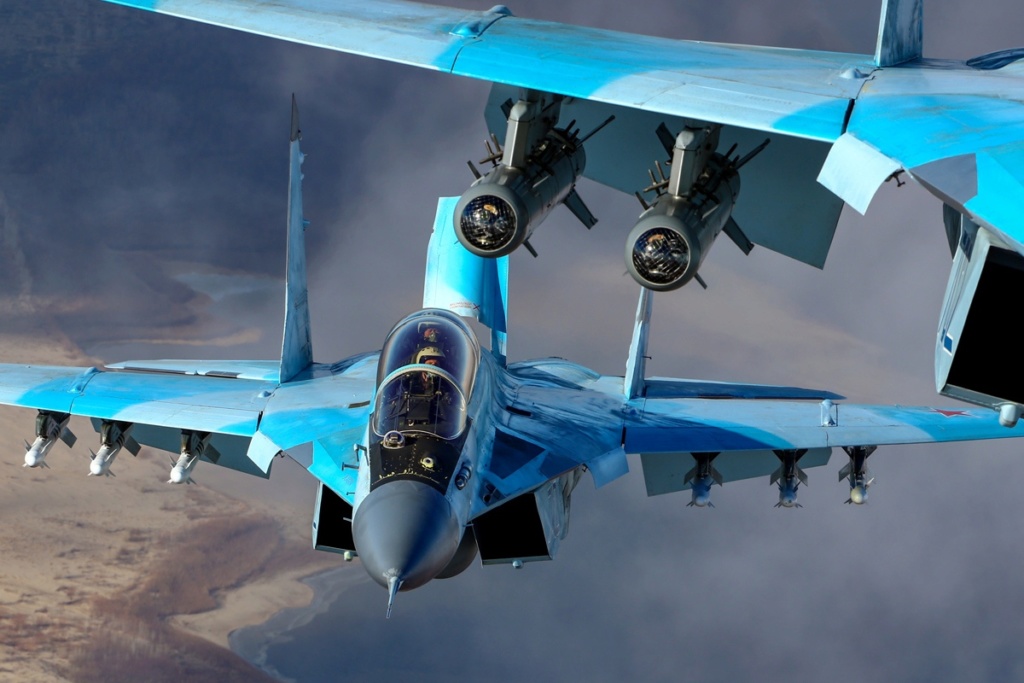Weight is weight, drag is drag. CFTs can be better than EFTs in many conditions (could agree on that) but are not better than a plane properly designed. The rest is just marketing talk.
CFT might be better than external fuel tanks when those EFT are being carried, but when the EFTs are dropped then all that drag goes away and you get all the manouver and speed and lower RCS back...
The Russians have the super CFT package... it is called the Flanker and is a MiG-29 with all of its fuel internally carried... most of the time they operate with half fuel loads because they don't need the extra fuel for most missions...
If planes A and B launch an IR missile, B being on A's six, missile coming from the former may well destroy A before its missile has even locked onto the target after being launched and having turned 180º. I do not know how the position of the target is updated from the carrier so the missile knows where to search (instead of for instance destroying the own launcher or a wingman), but I guess a missile that has no lock because its launcher has been destroyed cannot attack the first thing it finds. Consider B's missile gets the launcher speed as boost whereas A's needs to make a sharp turn that will slow it down substantially
The Russians don't have any lock on after launch missiles... only the Israelis and the west do... the simple fact is that under very few circumstances will one aircraft start off directly behind another one for an engagement... but even if the did the MiG pilot could pull back hard on the stick and yank his nose around... it does not need to point directly at the target... within 45 degrees is enough to get a lock with either R-27(E)T or R-73 and launch the missile... once launched all three missiles can track targets up to 75 degrees off boresight... and if he launches it is locked.
Most of the time the enemy could be detected from most angles but usually at distances where there is time to turn and point the nose close enough to the target to get a lock. For western aircraft at the time you pretty much had to point your nose directly at the target... about a 20 degree cone angle total compared with 90 degrees total for the Russian missiles...
NATO tests showed the R-73 was a very good missile, that was superior to their model Sidewinders of the time... the result was a crash update of the Sidewinder (AIM-9X) and enormous funding and priority for AMRAAM.
This is what I mean, have seen no detailed analysis of how this would actually develop considering relative positions of the opponents, analysis of the dynamics and effects of the countermeasures. Since this is a western style duel, small differences can be actually critical in regards of who is shot down and who survives.
Their flares didn't work against the R-73/27, and with thrust vectoring they could not out turn R-73 to evade it, and the HMS plus radar and IRST tracking means as soon as the MiG pilot saw a target he could lock and fire... often without needing to manouver at all... while other times a modest turn to get it into the kill zone...
The combination of that and passive radar guided AAMs had them screwed... the F-15 was in a worse position because its primary weapon was the Sparrow, but to lock on a Sparrow and guide it to a MiG-29 is to light up the MiG with a signal it could send a passive radar homing missile down... even the R-27R model was faster and longer ranged than Sparrow and the R-27ER of the Sukhois was even faster and longer ranged... more importantly when the F-15 with its superior radar detected the MiG and got its lock and fired its Sparrow the MiG could turn and launch an R-27R and then do what it liked, while the F-15 had to keep flying towards the MiG or it would lose lock and the Sparrow would hit the ground.
After losing a lot of F-15s, they would likely realise the problem and try to close the distance and use Sidewinders... HAHAHAHAHAHA... so they would have to run the gauntlet of R-27P SARH missiles and then R-73s... with HMS.
Well, apparently it was designed for that. The moment the plane and missile cross each other you can have massive relative angular speeds between them, hence the electronic beam steering.
Well that would suggest they are using a directed energy warhead to blast the fragments directly at the target, where ever the target might be as the missile blasts past.
More effective than just relying on a spherical blast when you don't know where the target is at point of detonation.











